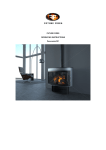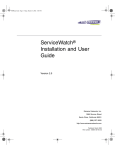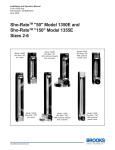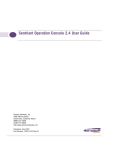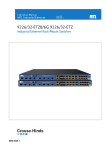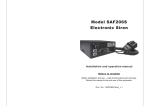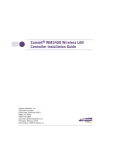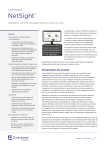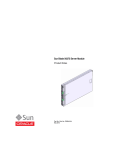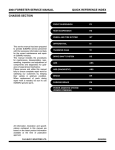Download Dormitory Wireless is a Snap
Transcript
Extreme Networks White Paper Dormitory Wireless is a Snap Leverage Existing CAT 5 Cable for Cost-Effective 802.11n Upgrade Make Your Network Mobile © 2011 Extreme Networks, Inc. All rights reserved. Do not reproduce. Extreme Networks White Paper: Dormitory Wireless is a Snap The Demand for Wi-Fi™ in Dormitories and Classrooms Higher education students today expect Wi-Fi connectivity. College-bound students are bringing three to four Wi-Fi devices to campus, including laptops, iPads and other tablets, smartphones and gaming systems. They expect to use all these devices not just across campus, but also in their dorm rooms. Until recently, most colleges and universities have concentrated delivering wireless connectivity in classrooms, lecture halls, libraries and cafeterias. Dorm rooms have been wired, which allows students to connect to a wired network. However, students not only desire mobility, but many of today’s devices – particularly tablets and smartphones – do not have an RJ-45 connector for an Ethernet connection. Students are demanding 802.11n Wi-Fi in their dorm rooms. To get wireless access, students sometimes attach their own access points, which is hard for the school to control and can create security risks. Students also want unmitigated access to their applications, which means the wired network is not impeding the throughput from the high-performance 802.11n wireless network. Challenges When Unwiring Dormitories Typically, dormitories are wired with two network drops per room, maybe more, depending on the number of students sharing the rooms. Pulling cable is expensive, and as the demand shifts toward mobility and portable Wi-Fi devices, universities are faced with another round of time-consuming and costly CAT 5/6 cabling to support installation of 802.11n access points installed in dormitory hallways. with Extreme Networks Wireless Mobility architecture and software, addresses the challenges that higher education institutions face. And the Extreme Networks family of high-performance switches provides the performance and intelligence to ensure fast, consistent throughput and additional security for wired switch ports. Altitude 4511 802.11n Wallplate Access Point Wireless access points have been traditionally designed to provide wireless service in relatively open spaces. While this works well for large spaces like lecture halls, cafeterias and libraries, it faces challenges with regard to planning and installation in multi-room facilities such as dormitories. In this white paper, we address a relatively unconventional means to quickly and cost-effectively overcome these challenges and provide high quality Wi-Fi without the conventional cost and hassle. The solution is simple – use a wallplate access point that can be quickly snapped into place (in minutes, not hours) on the wall inside the room and use the existing CAT 5/6 wires in the walls. And because the wallplate location is at the end of the room with the lowest attenuation (attenuations are obstructions to radio frequencies such as firewalls, firedoors, tile, mirrors, and water pipes), the radio quality from room to room is very strong – with minimal site survey and planning. Since the wireless wallplate is rather unconventional, we’ll address how it compares with the traditional thinking in each essential phase of wireless LAN planning, installation, and management. This approach does not leverage the investment in existing wired infrastructure and requires an extensive RF survey to ensure that the placement of access points (APs) will provide the appropriate coverage into the rooms. Today, higher education institutions are looking for solutions that leverage their existing infrastructure, have a lower cost to deploy, and are easier to manage. The Extreme Networks Altitude™ 4511 wallplate access point, Altitude 4511 Wallplate AP 2.75” x 5” x 1” (70mm x 125mm x 29mm) Altitude 4511 Wallplate AP Shown with optional Ethernet module 2 © 2011 Extreme Networks, Inc. All rights reserved. Extreme Networks White Paper: Dormitory Wireless is a Snap Design: Traditional Thinking The goal of the site survey is to determine the optimal placement of the minimum amount of access points to provide reliable RF coverage. This is a nice goal to have. However, this traditional thinking encumbers the network planning and installation. Installation in the Hallway Traditionally, access points are installed in hallways and push the power through firewalls, firedoors, and around mirrors. The site survey needs to plan for these RF attenuation factors and ensure adequate coverage within the room where the wireless service is needed the most. In many multi-room facilities, the hallway does not have plenum space. For example, there may be a hardcap ceiling to meet fire code regulations. The cost of installation can be very expensive and time-consuming. Another factor to consider is co-channel interference between APs installed in the hallway. These APs have little attenuation from AP to AP, and co-channel interference becomes an issue that must be dealt with in the management software. During the site survey, managing co-channel interference is rarely considered. Thus, the physical placement of the access point is a critical determinant of the wireless LAN success. A poor site selection for the access point is nearly impossible to correct. Typical corrective action usually involves a higher gain antenna or relocating the installation site of the access point – pulling more expensive cable in the process. 5643-01 Figure 1: Traditional Wireless Access Point Placement in the Hallway 3 © 2011 Extreme Networks, Inc. All rights reserved. Extreme Networks White Paper: Dormitory Wireless is a Snap Design: New Thinking The focus needs to be on proper RF planning, not physical installation. By installing the access point inside the room, the physical placement is always known. Installation density is easy to control and installation location is easy to change. When the access point is installed in the room, cochannel interference is greatly reduced. It is easy to understand why: the walls that attenuate the client signal also prevent one access point from interfering with another access point on the same channel. Pre-installation site surveys can now focus on the RF capacity planning and not the physical installation. This will lead to a more reliable site survey and a repeatable installation methodology. Figure 3 below shows a heat map of a deployment using Extreme Networks Altitude 4511. Note that the AP’s performance is concentrated inside the room rather than in the hall. Put the access point near the users for better performance 5639-01 Figure 2: New Altitude 4511 Access Point Placement in the Room Figure 3: Heat Map of a Deployment using Access Points in the Room 4 © 2011 Extreme Networks, Inc. All rights reserved. Extreme Networks White Paper: Dormitory Wireless is a Snap Installation: Traditional Thinking “Bring Out the Hammer Drill” The traditional method of installing access points in dormitories requires one to three hours per AP for the physical installation. Each facility can require a different installation, depending on the architecture of the building and how Ethernet cables can be routed to the APs. Concrete construction can make installation in the hallway an arduous task with ladders and hammer drills. During the site survey, it is equally important to pay attention to where and how the CAT-5/6 cabling will be installed. Installation: New Thinking The new thinking is towards creating a repeatable, consistent installation routine. Consistency is the first key to lowering installation cost. Installation teams are more effective when they follow a set routine and replicate the procedure at every site. Eliminating new cabling is the second key to lowering installation cost. In many dormitory wireless deployments the cost of new cabling is actually greater than the cost of the access points themselves. If a higher education institution has already invested in cabling the dorm rooms, it’s important to not let that investment go to waste as residents move from wired connectivity to wireless. The Altitude 4511 Installation is Simple 1. Remove the existing structured wiring plate 2.Install the universal bracket 3.Connect the pigtail RJ-45 cable from the access point to the structured cabling 4.“Hook and Snap” the access point to the bracket 90s WLAN Contollers: Traditional Thinking The traditional thinking is to use independent APs when only a few are installed and use an on-premises RF controller as a single point of management for many APs. However, many smaller facilities cannot afford the cost of a dedicated RF controller. So the property is left with either a large install of independent APs, or an expensive RF controller. WLAN Controllers: New Thinking Schools can obtain scalable management with Extreme Networks Wireless Mobility intelligence at the edge. For smaller deployments of 25 or less APs in a cluster, no additional controller is required as fullfeatured controller features are included in the Altitude 4511. Beyond management, the RF controller can optimize client roaming, detect Rogue APs, and manage the RF environment so the network is self-healing, redundant and always connected. For larger deployments the Altitude 4511 can be managed by the Extreme Networks Summit® WM3000 series of controllers and interoperate with Extreme Networks family of Altitude single, dual and tri radio indoor and outdoor access points. Extreme Networks Key WLAN Features High Scalability Each Altitude 4511 can operate as a standalone AP or act as a controller AP so that a cluster of up to 25 Altitude 4511 access points can be managed without a separate RF controller. The controller AP will provide central control and management along with self-healing access points and intelligent ACL for small facilities. For larger networks, dedicated RF controllers can be running Extreme Networks Wireless Mobility scale from hundreds to thousands of managed access points. Figure 4: Installation is Simple 5 © 2011 Extreme Networks, Inc. All rights reserved. Extreme Networks White Paper: Dormitory Wireless is a Snap Intelligence at the Edge High-Performance Radio By distributing stateful firewall policies to the access point at the edge, Altitude 4511 access points with Extreme Networks Wireless Mobility intelligence are protected from unwanted access at the first point of entry. This also enhances network capacity by not tunneling “bad” packets to the controller to be filtered and rejected. Extreme Networks APs have high-powered radios with equally high transmit and receiver sensitivity. The Altitude 4511 has a total output power of 26dBm on a single 2.4Ghz 802.11n chain. When combining two chains with 2x2 multiple-input and multiple-output (MIMO), the Altitude 4511 provides 29dBm of transmit power. At 5Ghz, the maximum radio power is 24.5dBm. This easily provides enough power for a single AP to support a high-capacity network of wireless tablets, laptops and other devices across multiple rooms. Self-Healing with Gap-Free Redundancy Leveraging market-proven SmartRF technology, Wireless Mobility networks automatically adapt to changes in the RF environment to provide coverage in case an access point fails, or interference is detected. Additionally, SmartRF tracks wireless clients and automatically adjusts power levels to maintain consistent connections for any type of mobile wireless device, such as a smartphone, tablet, game system, or laptop. Gap-free redundancy means that Extreme Networks Wireless Mobility networks are site-survivable in case communication to the controller is lost. It also means dynamic MESH links to move packets around a failed Ethernet segment. All done without administrator intervention. Universal Mounting The Altitude 4511 installation is a snap – literally. The universal mounting bracket has six different hole patterns matching telecom plates found around the world. The Altitude 4511 was designed to mount over a telecom plate – but that is not always practical or desired. To provide a flexible installation, the backside of the access point is flush with recessed connectors. This allows the access point to be installed over any surface; a telecom plate, on a desk, on a wall, on the ceiling, or above the ceiling in plenum space. Figure 5: Universal Mounting 6 © 2011 Extreme Networks, Inc. All rights reserved. Extreme Networks White Paper: Dormitory Wireless is a Snap Tamper-Proof One challenge for wireless deployments in dormitories is that some college students have a tendency to be curious about things installed on walls and in hallways. That’s why the Altitude 4511 was designed to be tamper-proof. First and foremost, the access point is located within the student’s dorm room for increased student accountability. Next, once installed, a small screwdriver is required to release the latch and remove the access point from the wall. A torx security screw is included in the shipping BOM so the latch cannot be removed without a special tool. Additionally, the Altitude 4511 LEDs can be disabled by network command. This prevents the AP from attracting unwanted attention when installed in an accessible location. Modular Ethernet Ports With the Altitude 4511, schools have an option to include an Ethernet port on the access point to offer a wired connection in the room, providing wireless coverage while still offering a wired connection. The Altitude 4511 can be upgraded with one or three Ethernet ports as needed for additional services such as wired LAN access or IPTV set-top box. When the network switching and power is provided by an Extreme Networks switch port configuration and identity-managed access, control can be extended right into the student’s room for all wired ports. Conclusion Colleges and universities have made large investments in wiring dormitories and residence halls. However, today’s students are using mobile devices and most of these devices do not come with a connector to plug a cable into. Today’s laptops, tablets and smartphones rely on Wi-Fi, specifically 802.11n for their connectivity, so students are demanding Wi-Fi in the dormitories. Campus administrators want a simple and effective way to deliver the new wireless service quickly, leveraging their existing wired investment to keep cost down. It is also beneficial to maintain a wired connection in the rooms, delivering both wired and wireless service. Extreme Networks delivers an innovative approach to solving the challenges of converting dormitories from just wired, to wired and wireless service. Extreme Networks Altitude 4511 uniquely enables administrators to meet student demands while achieving their business goals, with a cost-effective solution that is a snap to install, and can scale as their needs grow. Extreme Networks Snap-In Keystone Port In addition to Ethernet, there may be other connections required in the dorm room such as RJ-11 for analog telephone or F-connector for TV. When the Altitude 4511 is installed over the plate, the secondary network (RJ-11 or F-connector) can be exposed by snapping the connector into the keystone-style snap-in port. Actually, there are dozens of keystone-style connectors commonly used in voice, data and audio networks. All are supported via the keystone snap-in port. Wireline Networking While 802.11n provides very high throughput compared to 802.11abg, the high bandwidth demands of rich multimedia applications can easily congest the wired network. Extreme Networks provides a rich portfolio of intelligent and resilient Ethernet switches that can Make Your Network Mobile provide high-performance networking plus intelligent port configuration and identity-based access control, including detection and shunning of rogue wireless devices. Corporate and North America Extreme Networks, Inc. 3585 Monroe Street Santa Clara, CA 95051 USA Phone +1 408 579 2800 By providing resilient and intelligent wired and wireless networking solutions, Extreme Networks is making it easy for IT and easy for the student to have a great network experience, while making it economical for the school to offer premium network services. The company’s products include a family of indoor and outdoor wireless LAN access points and controllers in addition to access, aggregation and core switching platforms for the campus and data center. To find out how Extreme Networks can help make your network mobile, please visit us on the Web at www.extremenetworks.com. Europe, Middle East, Africa and South America Phone +31 30 800 5100 Asia Pacific Phone +65 6836 5437 Japan Phone +81 3 5842 4011 www.extremenetworks.com © 2011 Extreme Networks, Inc. All rights reserved. Extreme Networks, the Extreme Networks Logo, Altitude and Summit are either registered trademarks or trademarks of Extreme Networks, Inc. in the United States and/or other countries. iPad is a registered trademark of Apple Inc. Specifications are subject to change without notice. 1807_01 09/11










